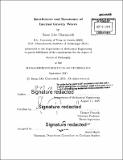| dc.contributor.advisor | Thomas Peacock. | en_US |
| dc.contributor.author | Ghaemsaidi, Sasan John | en_US |
| dc.contributor.other | Massachusetts Institute of Technology. Department of Mechanical Engineering. | en_US |
| dc.date.accessioned | 2016-03-03T21:07:07Z | |
| dc.date.available | 2016-03-03T21:07:07Z | |
| dc.date.copyright | 2015 | en_US |
| dc.date.issued | 2015 | en_US |
| dc.identifier.uri | http://hdl.handle.net/1721.1/101532 | |
| dc.description | Thesis: Ph. D., Massachusetts Institute of Technology, Department of Mechanical Engineering, 2015. | en_US |
| dc.description | Cataloged from PDF version of thesis. | en_US |
| dc.description | Includes bibliographical references (pages 91-96). | en_US |
| dc.description.abstract | Internal waves are propagating disturbances within stratified fluids, arising from a balance of gravity, buoyancy, and rotation. As well as being of fundamental scientific interest, they are ubiquitous in a variety of forms in the Earth's oceans, where they are responsible for driving vertical mixing. And it is the rule, rather than the exception, that internal waves propagate through a varying background density stratification. We begin by theoretically studying internal waves that are harmonically forced at a horizontal level above a semi-infinite, non-uniform density stratification. Starting with a two-layer model, we identify the existence of resonance peaks and diminution troughs in the wave transmission spectra, and provide physical insight through the application of ray theory. Thereafter, we proceed to consider smoothly varying stratifications, demonstrating that these resonance and diminution features persist beyond simple models. We conclude by considering the relevance of the results to geophysical settings. As an example, we demonstrate that an ocean stratification is inherently tuned to transmit internal wave energy to the deep ocean at specific combinations of wavelength and frequency. Subsequently, we perform a laboratory experimental study of an internal wave field generated by harmonic, spatially-periodic surface forcing of a strongly-stratified, thin upper layer sitting atop a weakly-stratified, deep lower layer. In linear regimes, the energy flux associated with relatively high frequency internal waves is prevented from entering the lower layer by virtue of evanescent decay. In the experiments, however, we find that the development of parametric subharmonic instability (PSI) in the upper layer transfers energy from the forced primary wave into a pair of subharmonic daughter waves, each capable of penetrating the weakly-stratified lower layer. We find that around 10% of the primary wave energy penetrates into the lower layer via this nonlinear wave-wave interaction for the regime we study. With an emphasis on assessing the role of interference in tuning wave transmission, we perform a series of laboratory experiments in order to measure resonance and diminution in the aforementioned non-uniform stratification. We find that the occurrence of destructive interference in the upper stratification layer naturally yields diminution of the transmitted wave. Conversely, constructive interference results in a notable amplification of the wave field over time scales on the order of the forcing period; the development of nonlinear wave-wave interactions due to wave amplification is observed over longer time scales. Good agreement is obtained between the experimental results and a weakly viscous, long wave model of our system within the linear regime. Given the ubiquity of layering in environmental stratifications, an interesting example being double-diffusive staircase structures in the Arctic water column, we furthermore present the results of a joint theoretical and laboratory experimental study investigating the impact of multiple layering on internal wave propagation. We first present results for a simplified model that demonstrates the nontrivial impact of multiple layering. Incident waves of particular length and time scales can experience constructive interference taking place within the alternating stratified and mixed layers, which in turn appreciably enhances wave transmission. Thereafter, utilizing a weakly viscous, linear model that can handle arbitrary vertical stratifications, we perform a comparison of theory with experiments finding excellent qualitative and quantitative agreement. We conclude by applying this model to a case study of a staircase stratification profile obtained from the Arctic Ocean, finding a rich landscape of transmission behavior. | en_US |
| dc.description.statementofresponsibility | by Sasan John Ghaemsaidi. | en_US |
| dc.format.extent | 96 pages | en_US |
| dc.language.iso | eng | en_US |
| dc.publisher | Massachusetts Institute of Technology | en_US |
| dc.rights | M.I.T. theses are protected by copyright. They may be viewed from this source for any purpose, but reproduction or distribution in any format is prohibited without written permission. See provided URL for inquiries about permission. | en_US |
| dc.rights.uri | http://dspace.mit.edu/handle/1721.1/7582 | en_US |
| dc.subject | Mechanical Engineering. | en_US |
| dc.title | Interference and resonance of internal gravity waves | en_US |
| dc.type | Thesis | en_US |
| dc.description.degree | Ph. D. | en_US |
| dc.contributor.department | Massachusetts Institute of Technology. Department of Mechanical Engineering | |
| dc.identifier.oclc | 939919967 | en_US |
